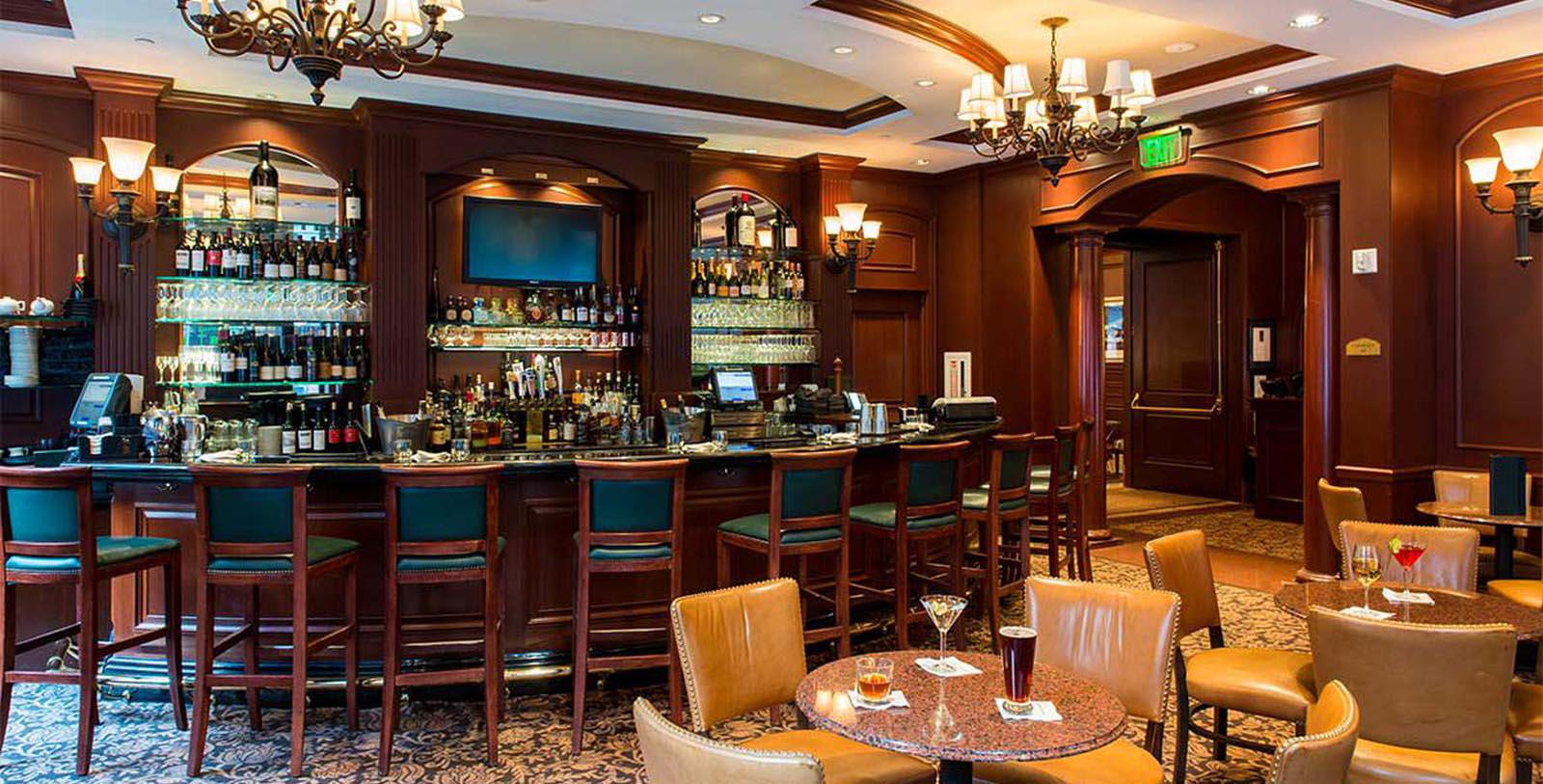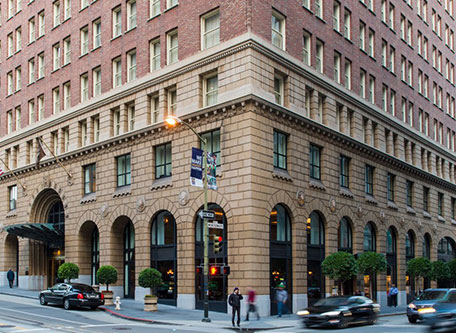Receive for Free - Discover & Explore eNewsletter monthly with advance notice of special offers, packages, and insider savings from 10% - 30% off Best Available Rates at selected hotels.
history
Discover the Omni San Francisco with its charming Florentine Renaissance design.
Omni San Francisco, a member of Historic Hotels of America since 2010, dates back to 1926.
VIEW TIMELINEThe Omni San Francisco is celebrated today for its timeless elegance and historical prestige. But while the building is now a splendid historic hotel, it originally started life as a bank facility called the Financial Center Building. Raised in 1926, the location was designed by reputed local architect Frederick H. Meyer. He had designed a number of noteworthy structures across San Francisco prior to his work on the Financial Center Building, such as the Bill Graham Civic Auditorium, the Rialto Building, and the Pacific Gas & Electric Co. Building. Dozens of these structures are recognized by the State of California as local historic landmarks. A few have even been listed on the National Register of Historic Places by the U.S. Department of the Interior. Meyer and his colleagues choose to use Renaissance Revival-style architecture for the building’s entire layout, which it displayed magnificently throughout its granite façade. Amazingly, it took Meyer just nine months to complete the Financial Center Building. The structure quickly became one of the most important monetary institutions in downtown San Francisco when it finally debuted, going on to host all sorts of banks and financial businesses for the remainder of the century.
Yet, the Financial Center Building was not the first structure to occupy the plot of land at 500 California Street. On the contrary, a renowned local landmark called the “Parrott’s Granite Block” had resided at the site as early as 1852. Constructed by a Tennessean named John Parrott, the building became famous within the local community for its stunning Chinese granite exterior. Parrott’s Granite Block also had a close connection to San Francisco’s financial community, as it originally served as the headquarters for two regional banks—Adams & Company, and Page, Bacon & Company. Those two entities went bankrupt, though, due to the tough economic conditions caused by the Panic of 1855. Another local bank—Wells Fargo—managed to weather the storm and acquired the assets of the other two financial institutions. Wells Fargo subsequently moved into Parrott’s Granite Block, establishing its headquarters inside the three-story structure. The building remained a local attraction for the next several decades and helped spur the growth of the surrounding Financial District. Parrott’s Granite Block entered a period of decay around the start of the 1920s, however, which led to its eventual demolition shortly thereafter.
Omni Hotels and Resorts eventually bought the Financial Center Building in 2002, investing millions to convert it into a luxurious boutique hotel. Prior to Omni’s acquisition of the historic structure, the Financial Center Building had sat dormant for close to a decade. As such, the company’s thorough refurbishment of the structure did much to save its brilliant architectural features. Within a matter of months, Omni managed to transform the erstwhile financial institution into a beautiful 362-room hotel called the “Omni San Francisco Hotel.” The building has since gone on to become one of San Francisco’s most cherished holiday destinations, receiving numerous accolades for its unrivaled hospitality. Several prestigious travel publications have identified the Omni San Francisco Hotel as one of the most fantastic places to visit in California, including Condé Nast Traveler, Egencia, and U.S. News & World Report. The hotel even joined Historic Hotels of America in 2010, as well as its sibling program—Historic Hotels Worldwide—some three years later. Few places are truly better for a historic vacation in San Francisco than this fantastic historic location.
-
About the Location +
The Omni San Francisco resides in the heart of San Francisco’s vibrant Financial District. The neighborhood is home to some of the nation’s most powerful businesses, including the McKesson Corporation, Wells Fargo, PG&E, Gap, Charles Schwab, Levi Strauss & Co., and Bechtel. But while the locality is one of the city’s most important areas, its origins were far humbler in nature. Under Spanish and Mexican rule, the location was the site of a harbor named “Yerba Buena Cove.” A small military outpost called “Yerba Buena” also sprang up in the area, which served the military garrisons of the Presidio of San Francisco and Mission Dolores. The territorial government responsible for Yerba Buena typically discouraged settlement, as the marshy topography greatly impeded the proliferation of large-scale agriculture. Most of the people who arrived were redirected to the Pueblo of San José further south. The layout for an actual community did not emerge until the 1830s, when maritime commerce became a reliable source business in that region of California. The seaport quickly attracted European and American investors in particular, which started to cultivate a unique cosmopolitan atmosphere.
After gold was discovered in the Sierra Nevada Foothills in 1848, Yerba Buena's location near San Francisco Bay acted as a magnet for further commercial development. Following California’s independence and subsequent annexation by the United States, Yerba Buena and the other communities lining the Bay expanded rapidly. Eventually, Yerba Buena and its neighboring settlements were all incorporated into the new City of San Francisco in 1850. Yerba Buena specifically saw an explosion of growth along Montgomery Street that went all the way up to The Embarcadero. The economic activity spurred on by the Gold Rush and the local shipping industry transformed San Francisco into the leading financial institution, with the Yerba Buena neighborhood at its epicenter. Banks and other financial institutions sprung up throughout Yerba Buena, leading to the construction of the city’s first skyscrapers. Many of those storied buildings still stand today, even after much of the surrounding area was destroyed during The Great San Francisco Earthquake of 1906. Soon enough, San Franciscans had taken to calling the area the “Financial District.”
Construction in the area continued unabated during the early 20th century, with a myriad of low-rise, masonry clad buildings coming to define the skyline. But work on new skyscrapers stopped dramatically as a result of the Great Depression. The neighborhood managed to recover some 20 years later, leading to an economic boom that lasted all the way through the 1980s. Yet, some critics asserted that the newer skyscrapers had threatened the historical character of the Financial District. As such, city officials passed regulations that diminished the size and scope of the projects. Most of the real estate developments that transpired afterward occurred south of Market Street, which led many to call the area the “South Financial District.” The Financial District as a whole has since become one the world’s leading centers for trade and commerce. It is also close to numerous cultural attractions, including Chinatown, the Yerba Buena Gardens, and the San Francisco Museum of Modern Art. Many more fascinating destinations are located a bit further way, too, such as Fisherman’s Wharf, the Asian Art Museum, and the San Francisco Maritime National Historical Park.
-
About the Architecture +
The Omni San Francisco showcases some of the finest Renaissance Revival-style architecture in all of San Francisco. Renaissance Revival architecture—sometimes referred to as "Neo-Renaissance”—is a group of architecture revival styles that date back to the 19th century. Neither Grecian nor Gothic in their appearance, Renaissance Revival-style architecture drew inspiration from a wide range of structural motifs found throughout Early Modern Western Europe. Architects in France and Italy were the first to embrace the artistic movement, who saw the architectural forms of the European Renaissance as an opportunity to reinvigorate a sense of civic pride throughout their communities. As such, those intellectuals incorporated the colonnades and low-pitched roofs of Renaissance-era buildings, with the characteristics of Mannerist and Baroque-themed architecture. Perhaps the greatest structural component to a Renaissance Revival-style building involved the installation of a grand staircase in a vein similar to those located at the Château de Blois and the Château de Chambord. This particular feature served as a central focal point for the design, often directing guests to a magnificent lobby or exterior courtyard. Yet, the nebulous nature of Renaissance Revival architecture meant that its appearance varied widely across Europe. As such, historians today often find it difficult to provide a specific definition for the architectural movement.
-
Film, TV and Media Connections +
The Matrix 4 (2021)































